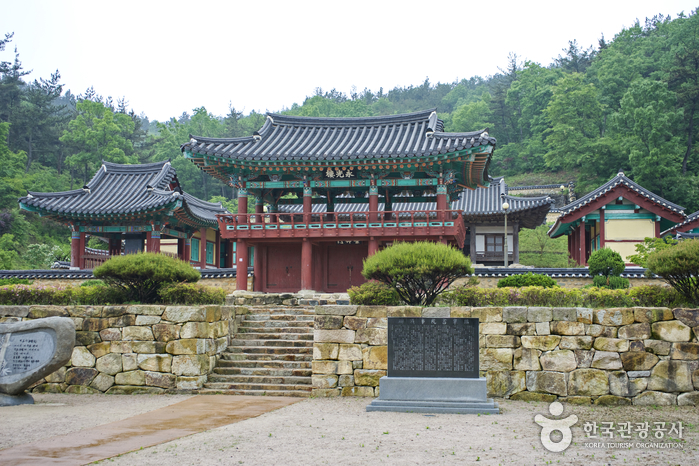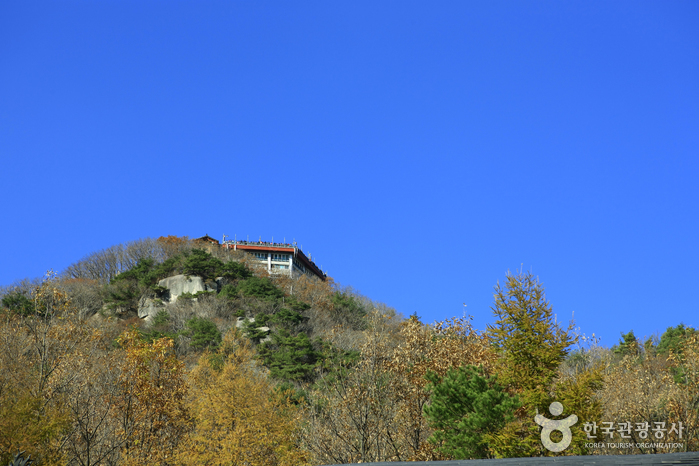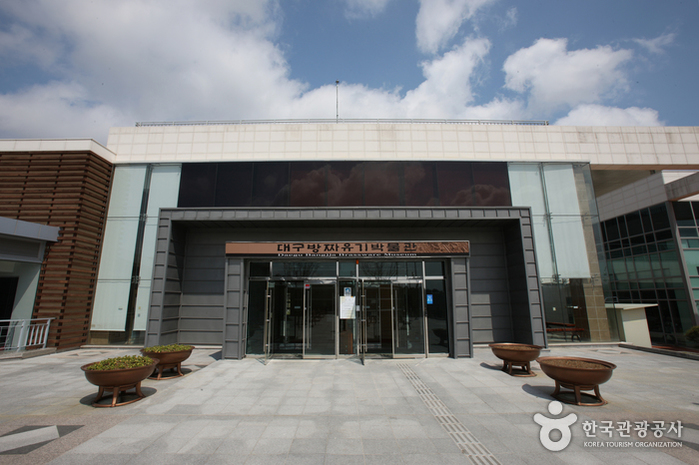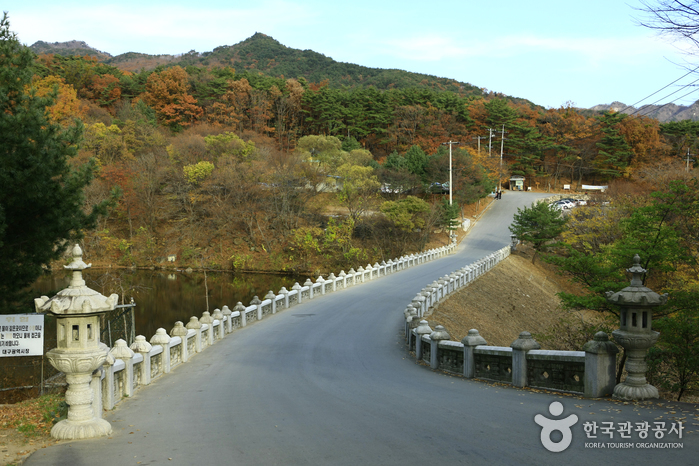The Gwiae Traditional House [Korea Quality] / 귀애고택 [한국관광 품질인증]
9.3Km 7568 2020-09-08
37-17, Gwiho 1-gil, Hwanam-myeon, Yeongcheon-si, Gyeongsangbuk-do
+82-54-331-8043
The Gwiae Traditional House is a 200-year-old aristocrat’s residence consisting of various hanok structures, a pavilion, a pond, and a shrine set amid its expansive grounds. Located in Yeongcheon Byeolbyeol Misulmaul (Star Art Village) where modern artworks can be seen here and there, the house too is surrounded by various artworks as well as the beautiful natural environment of Yeongcheon, including Bohyeonsan Mountain, Palgongsan Mountain, Unjuhan Recreational Forest, and Saryongsan Mountain. Thanks to the Art Village project, the village has acquired a distinguished charm all its own by combining the antique beauty of traditional houses with modern art and public design. The village is full of attractions as well as traditional structures, including Pungyeongjeong Pavilion, which was built to commemorate the life of Gwon Eung-do, an eminent Confucian scholar of Joseon, and the Cian Art Museum, which established in a closed-down school and has three exhibition rooms, an outdoor sculpture park, and an art shop.
Belonging to the descendants of Jo Geuk-seung (1803∼1877), a Confucian scholar of the late Joseon period, the Gwiae Traditional House comprises a sarangchae (detached building), an anchae (women’s quarters), a daemunchae (building next to the gate), and Gwiaejeong Pavilion (Gyeongbuk Provincial Cultural Heritage No. 339), which has double-layered eaves and a half-hipped roof, and measures four kan (a unit of measurement referring to the distance between two columns) at the front and three kan at the sides. There is also a hexagonal pavilion connected with a bridge and a lotus pond. The house also has four installation artworks such as a sculpture of a child and a puppy getting stars, and a turtle sculpture with Lee Geum-hong’s calligraphy.
Opened as a hanok stay in 2013, the house has 8 guestrooms and offers a variety of traditional games such as Tuho (Arrow-throwing), Neolttwigi (Korean see-saw game), and Jegichagi (Korean shuttlecock game) in the courtyard.
Imgoseowon Confucian Academy (임고서원)
10.3Km 30993 2024-02-23
447 Poeun-ro, Imgo-myeon, Yeongcheon-si, Gyeongsangbuk-do
Imgoseowon Confucian Academy, established in 1553, was built to commemorate the esteemed Goryeo statesman Jeong Mongju. Visitors can explore Munchungsa Shrine, the sanctuary of his ancestral tablet, and Jonyeonggak Pavilion, where his portrait is displayed. Heungmundang Hall, historically used as a lecture hall, is also a significant site within the academy. Among the treasured relics, the academy holds three portraits of Jeong Mongju and a collection of over 200 books. A highlight is the Books of Imgoseowon Confucian Academy, an esteemed compilation of twenty-five volumes across ten categories, recognized as a national Treasure. Furthermore, the grounds are graced by a revered ginkgo tree, recognized as a monument, and the Stele of Jeong Mongju, each adding to the rich cultural tapestry of the site.
Palgongsan Provincial Park (Gatbawi Section) (팔공산도립공원(갓바위지구))
11.7Km 27396 2021-03-04
Wachon-myeon, Gyeongsan-si, Gyeongsangbuk-do
+82-53-981-6406
Located north of Gyeongsan, Palgongsan Mountain (altitude 1,192.3 meters) was called both Jungaksan and Buaksan Mountain during the Silla period. The mountain has many ancient temples and historical sites such as the Gatbawi Stone Buddha, Wonhyosa Temple, Cheonseongsa Temple and Bulgulsa Temple.
Palgongsan Provincial Park (Eunhaesa Temple Section) (팔공산도립공원 - 은해사지구)
12.9Km 9641 2019-07-23
Geojo-gil, Yeongcheon-si, Gyeongsangbuk-do
+82-54-852-8031
Located north of Gyeongsan, Palgongsan Mountain (1,192.3m) was called both Jungaksan and Buaksan Mountain during the Silla period. The mountain has many ancient temples and historical sites such as the Gatbawi Stone Buddha, Wonhyosa Temple, Cheonseongsa Temple and Bulgulsa Temple.
Daegu Donghwasa Temple (동화사(대구))
15.0Km 71616 2023-11-14
1 Donghwasa 1-gil, Dong-gu, Daegu
Donghwasa Temple is located on the south side of Palgongsan Mountain, about 22 km northeast of Daegu. It was built by Monk Geukdal in the 15th year of King Soji’s reign (AD 493). The original name of the temple was Yugasa Temple, but Simjiwangsa rebuilt the temple under King Heungdeok (r. AD 826-836) and named it Donghwasa Temple, which means "the paulownia tree blooms even in winter," in reference to the blooming trees around the temple. Most of the present temple buildings were constructed between 1723 and 1732.
Orijangnim Forest in Jacheon-ri, Yeongcheon (영천 자천리 오리장림)
15.0Km 11984 2021-06-11
1421-1, Jacheon-ri, Yeongcheon-si, Gyeongsangbuk-do
+82-54-330-6584
Orijangnim Forest is approximately 2 kilometers long, the same length as the Korean measurement of five ri (O-ri). It is also called Jacheon Forest due to its location near Jacheon-ri. The forest was split into two parts after a national roadway was built through the forest. Later, much of the forest was lost due to additional building construction, road expansion, and typhoon. Only some areas in front of Jacheon Village retain the old ambience.
Orijangnim Forest was established to block the strong winds from entering the village, as well as provide bank protection and flood prevention. It is comprised of 280 trees from 12 different species including oriental oaks.
Daegu Bangjja Brassware Museum (대구 방짜유기박물관)
15.1Km 14430 2019-03-19
29, Dojang-gil, Dong-gu, Daegu
+82-53-606-6171~4
Bangjja Brassware Museum is the first original museum of its kind in Korea. Unknown to many, Bangjja Brassware possesses a host of beneficial attributes and is used both for storing food and for growing plants. One of its primary functions is that of cultivating nutritive elements.
The Bangjja Brassware Museum in Daegu has numerous brassware products on hand that were generously donated by Lee Bong-Ju. His collection was subsequently appointed intangible cultural asset number seventy-seven by the Korean government.
The museum’s layout is rather intricate. Both the basement floor and second ground floor consist of three exhibit halls, a data research hall, a cultural experience hall, a video education hall, an outdoor stage, and several planning exhibit halls. In the Brassware Cultural Hall, a display boasting Korea’s history regarding various kinds of brassware, together with other relevant information is on hand for visitors. In the nearby Donation Hall, a National Intangible Cultural Heritage, Lee Bong Ju’s luxury brassware collection, is on display. In the Reappearance Hall there are makeshift displays illustrating where brassware was first produced and where it was traded.
Palgongsan Nature Park (Gatbawi District) (팔공산자연공원(갓바위지구))
15.6Km 61419 2024-02-29
6-1 Palgongsan-ro 199-gil, Dong-gu, Daegu
+82-53-939-0080
Palgongsan Nature Park, located in the Taebaek Mountain Range, features three peaks: Birobong Peak (1,192m), Yeombulbong Peak (1,042m), and Seobong Peak (1,150m). This mountain area boasts stunning rock formations and valleys. At an elevation of 852 meters on Gwanbong Peak, the Gatbawi Rock is renowned for fulfilling wishes. Other attractions include Donghwasa Temple, the Palgongsan Cable Car, and the Donghwasa Tourist Complex.
Palgongsan Natural Park (Donghwasa Temple District) (팔공산자연공원(동화사지구))
15.6Km 34508 2021-07-21
1, Donghwasa 1-gil, Dong-gu, Daegu
+82-53-939-0080
Palgongsan Natural Park is located close to Palgongsan Mountain, one of the larger mountains in the Taebaek Mountain Range. Palgongsan Mountain is located 20 kilometers northeast from downtown Daegu, where the Nakdonggang and Geumhogang Rivers meet. The mountain has three peaks in a row: Birobong Peak (1192.3 meters) in the center and Dongbong (aka ‘Mitabong,’ 1,155 meters) and Seobong (aka ‘Samseongbong,’ 1,150 meters) on each side.
The park is within the administrative district of Dong-gu, Daegu and has four towns along its border including Yeongcheon-si, Gyeongsan-si, and Chilgok-gun. A number of Buddhist temples including Donghwasa, the headquarters of the 9th Buddhist Parish, are located in the area.
The park has numerous rocks and valleys and is carpeted with azaleas in the spring. In the autumn many visitors flock to the park to admire the fall leaves on the trees lining the 16.3-kilometer-long roadway that runs through the park. With vibrant green leaves in spring and a delicate snowscape in the winter, Palgongsan Mountain is an attractive destination for visitors throughout the year.
![The Gwiae Traditional House [Korea Quality] / 귀애고택 [한국관광 품질인증]](http://tong.visitkorea.or.kr/cms/resource/84/2578084_image2_1.jpg)





 English
English
 한국어
한국어 日本語
日本語 中文(简体)
中文(简体) Deutsch
Deutsch Français
Français Español
Español Русский
Русский